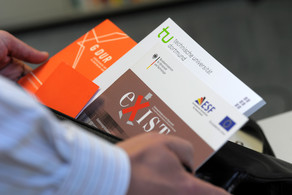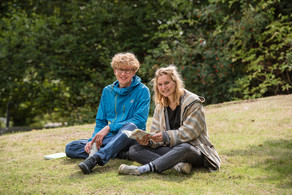E-bike Designed at TU Dortmund University Sets Guinness World Record
- Research
- Top News
- Press Releases
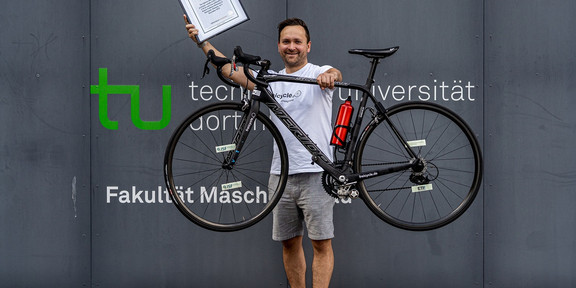
“Once the design for the e-bike, which was developed at TU Dortmund University, was completed, there was still a long way to go before it was finally entered in the book of records,” explains Dr. Freiburg. Independent performance tests on the battery and the drive system had to be conducted. But now he’s made it: The officially lightest e-bike in the world comes from Dortmund and is more than just extremely light. Anyone thinking now that savings were made in the prototype’s performance just to achieve the lowest possible weight is mistaken: The drive system can accomplish far more than the prescribed 250W and was only throttled due to legislation. The rechargeable battery is naturally smaller than that of conventional e-bikes, but here too GUINNESS WORLD RECORDS© set down a fixed target. Depending on the degree of support provided by the motor, a range of 19 to 35 kilometers is possible.
What concept lies behind this world champion e-bike? You take a bicycle frame plus wheels made of an ultralight material, the electric motor for a remote-controlled model helicopter, a water bottle, a rechargeable battery and small electrical parts, combine all this with German engineering expertise, add customized components, season with self-developed software – and the lightest electric bicycle in the world is ready to go. However, developing the bike was naturally not quite so simple: Dennis Freiburg, mechanical engineer, mobilized a lot of know-how and support among his colleagues in order to put the ultralight model on the road.
The rechargeable battery is housed in a water bottle
The e-bike’s frame is made of carbon. It was produced and placed at Freiburg’s disposal by Merida, German manufacturer of top-of-the-range bicycles. He attached the electric motor under the frame with a custom-made mount. The motor transfers its power via a friction roll to the rear wheel. “This is a very direct type of drive,” says Freiburg. He considers slightly increased wear of the rear wheel to be a disadvantage of this kind of power transmission.
Freiburg, an engineer who previously worked at the Institute of Machining Technology of TU Dortmund University, has housed the rechargeable battery in a commercially available water bottle, which he adjusted on the inside so that he was able to accommodate not only the battery but also the control electronics. Freiburg installed the software for his bike via a USB port in the bottle.
Functional parts from a 3D printer
In general, the e-bike can easily be used as a normal bicycle, as it weighs only about half a standard bicycle. To activate the e-drive, Freiburg turns the cap of the water bottle. He has redesigned this “lid” to form an on/off switch. In addition, he can regulate the power and level of support provided by the electric motor by turning the cap. This is possible because Freiburg has substituted the original lid with a cover that houses the corresponding electronics. He used a 3D printer to make this “lid” as well as other components, for example the brake mounts.
The battery power is enough for about 25 to 40 kilometers when the electric drive is switched on. “For a longer range, I can simply attach a second battery,” says Freiburg. Sensors on the rear wheel transmit speed data to the bicycle’s electronic control unit, sensors in the chainring tell it whether the rider is pedaling. The electric motor operates when the e-bike is going at speeds of to 25 kilometers per hour. “That’s the legal limit,” says Freiburg. “From 25 kilometers onwards, I’m naturally considerably faster when I use muscle power. After all, the bike doesn't weigh much.”
Dr. Freiburg remarks: “Without the people who supported and vouched for me as well as my wife’s patience, the project would have been impossible.” He particularly thanks the Institute of Machining Technology of TU Dortmund University, including Professor Dirk Biermann, bicycle manufacturers Merida, and Yan Rudall, who all supported the project from the outset. His thanks also go to the Institute of Electrical Engineering (ETI) of the Karlsruhe Institute of Technology and to velotech, a cycling equipment company, which both supported the project in its final phase.
Further information on the project:
Contact for further information:



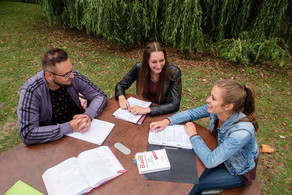

![[Translate to English:] Partner Four hands are holding the green logo of TU Dortmund University](/storages/tu_website/_processed_/1/d/csm_Partner_Nicole_Rechmann_KW_670eba0154.jpg)

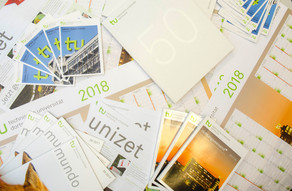
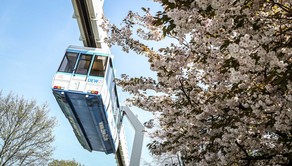
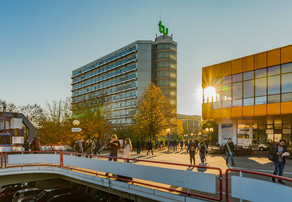
![[Translate to English:] Forschung An apparatus with tubes in a laboratory](/storages/tu_website/_processed_/0/c/csm_Forschung_Juergen_Huhn_4fa3153b51.jpg)
![[Translate to English:] Studium Five students are sitting in a lecture hall. They are talking to each other.](/storages/tu_website/_processed_/c/9/csm_Studium_FelixSchmale_dbdbfb0dd7.jpg)
